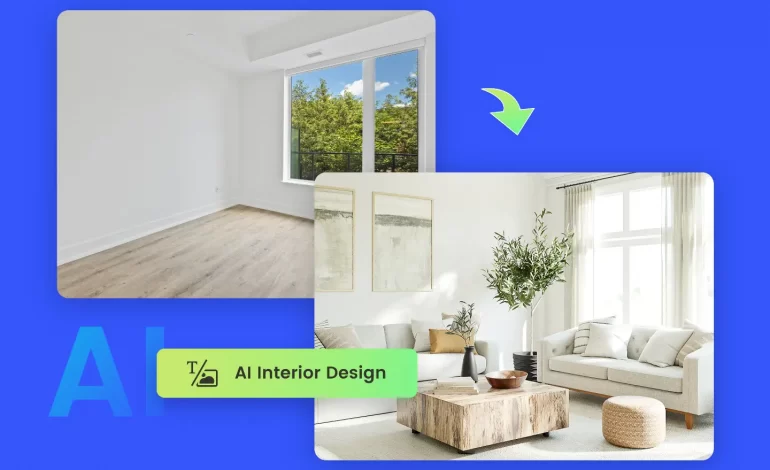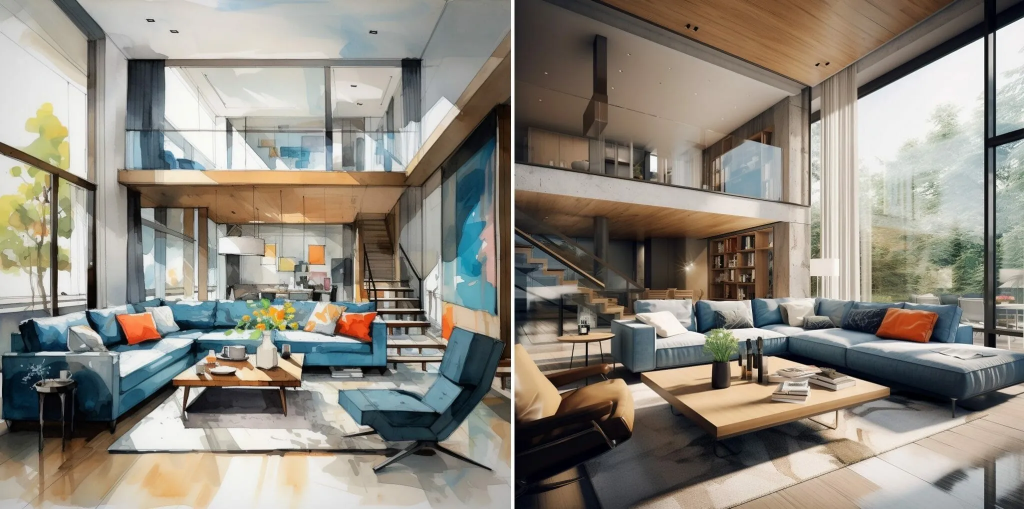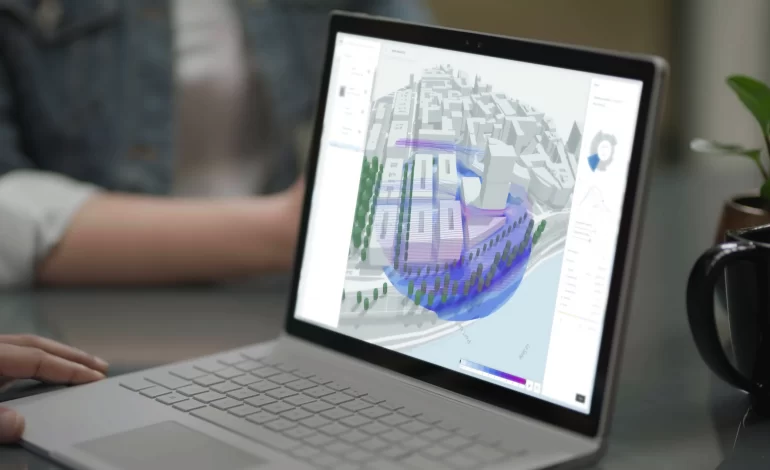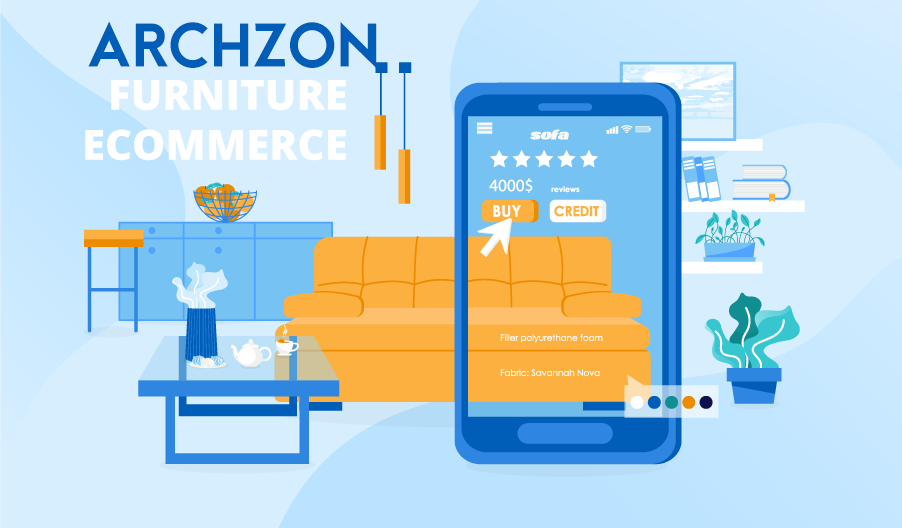
AI Interior Design: 10 Best AI Interior Apps and Tools for Your Room Design in 2023

Imagine this: AI interior design is a game-changer in the worlds of design and decor, making design choices as simple as pie. Like a trusted friend, it aids in brainstorming, and vendor research, and even lets you peek into the future with 3D visuals. Well, the future is here as AI is quickly starting to transform the interior design space with its approachable tools that are accessible to people everywhere.
Our team has been on quite a journey, exploring some brilliant AI interior design apps out there. We’re eager to share a curated list of the best AI interior design tools that are taking the world by storm right now.
List of AI Interior Design Apps and Tools in this Guide
How to Use Artificial Intelligence in Interior Design

Modern living/dining and kitchen design by Decorilla Online Interior Design
Like any specialized tool, AI for interior design needs some getting used to. That said, these programs are often user-friendly, especially once you know how to communicate to get what you’re looking for. And the way to do that is usually through prompts, aka simple text commands.
Here are the simple steps to follow with AI interior design:
- Pick an AI interior design app with a robust AI component that adapts to your needs. Fortunately, you have your pick of the best as we look at the top options below!
- Set clear parameters by defining your preferences. This can include your preferred room, style, colors, furniture arrangement, budget, and any other key elements you want. Knowing what you want and how to communicate it is key.
- Specify the type of visualization you want such as 3D, CAD drawing, mood board, or floor plan. Knowing how much detail you’ll need and the format you want will help you get the best results. 3D visualizations in landscape format are usually great for general contractors to work with if you have to hand them off to a professional.
- Provide feedback on your AI interior design to refine the final image.
- Experiment! Try different tools to get a myriad of inspiration. You can use a combination of two or more tools for the best results.
Get the best of both worlds with AI-assisted interior design + a professional designer! Book a Complimentary Call to get started today!
Choosing the Right AI for Room Design

Decorilla integrated AI interior design living room inspiration
Creating your ideal space goes hand in hand with picking the right tool or process for your interior design needs. So, consider the app’s features, user-friendliness, reviews, cost, and support options. If you prefer a more hands-on approach, consider one of the top online interior design services instead.
Here are the top-rated Interior AI apps on our list:
- Best Overall Interior Design App: Midjourney
- Best Personalized AI Interior Designer: Decorilla
- Top Free AI Room Design Tool: Bing Image Creator
- Best Offline AI Interior Design App: DiffusionBee
- Most Versatile Interior Design AI Generator: OpenArt
Best AI Interior Design Apps and Tools
1. Midjourney

Image Credit, Midjourney
HOW IT WORKS: Craft stunning artificial intelligence interior design through accurate and helpful commands on Midjourney. Sign up first, then start by typing your prompt after entering /imagine. It’ll generate four AI images, and you can select your favorite. You can use this as a starting point for more generations or request a higher-resolution version. And if you don’t like any of these, you can ask the AI bot to try again. It’ll then provide a new set of rooms. Alternatively, you can paste an example image’s URL into the chat as a reference for the AI generator. This AI model was trained on existing images from the internet so if your request is common, it usually provides stunning results. But if you’re looking for something that is less common, it may struggle.
Tips: Adding keywords like “photo of”, “4K”, and specifying the aspect ratio “–ar 16:9” tends to produce the most realistic and beautiful results. You can even specify the camera angle, a furniture brand that has the style you want, and the type of lighting to refine your AI interior design results! Keep in mind that Midjourney V5 works best with natural language. So use sentences to describe what you want for the most accurate depiction. Here’s a helpful tutorial that sets out all you need to know about using Midjourney.

Image Credit, Midjourney AI Interior Design
Midjourney Pros:
- Realistic renderings and adaptations are available.
- If you weren’t happy with the initial generation, you could regenerate an image according to your prompt.
- Various settings are available to tweak your rendering.
- You can use a reference image in combination with prompts.
Midjourney Cons:
- Not specific to your room dimensions.
- Cannot edit images or specify unwanted elements.
- Only accessible with Discord.
- Only available for paid accounts, with subscriptions ranging from $10 to $60 per month.
- Cannot include exact or existing pieces.
2. Decorilla Online Interior Design

Contemporary living room design Decorilla Online Interior Design
HOW IT WORKS: Decorilla brings the best of both worlds to dwellers everywhere. It integrates AI tools, Augmented Reality, and Virtual Reality technology into its unique approach. And paired with expert interior designers, the hybrid model creates photorealistic virtual designs. They tailor interiors to precise requirements after you start with an interactive questionnaire.
With Decorilla AI interior designer, clients receive accurate 3D models, inspiration from multiple designers, professional guidance, a color palette, a floor plan, and an online shopping list with great designer discounts. First, you’ll start the project with a quick-style quiz. After pinpointing your preferences, it moves on to a personalized consultation to define the design scope. From here, you will find real interior designers who specialize in your style. They’ll provide professional visual concepts for your interior and you get to pick your favorite designer and work with them online. Your chosen interior designer will work with you to perfect your space. In the end, you’ll receive photorealistic virtual renderings of your actual new room. You also receive help with your shopping process with their white-glove shopping concierge service.

Eclectic bedroom design by Decorilla online interior design
Decorilla’s recent updates include integrating AI and machine learning into its platform. Exciting additions include cutting-edge algorithms to analyze clients’ design preferences, style, and past interactions. These insights let interior designers grasp unique client styles and requirements for highly tailored results. Decorilla also uses AI interior design for customer quality assurance, personalized designer tools and training, and analyzing industry trends so that they can provide clients with insights into emerging design styles and popular products.

Luxe contemporary living room by Decorilla online interior design
Decorilla Pros:
- A hybrid AI model that gets you visual concepts from multiple interior designers who can customize precise designs.
- You can incorporate new and existing pieces with accuracy into your space design.
- You’ll receive designer furniture discounts that often cover the cost of the package and an easy-to-use online shopping list.
- They provide floor plans, color palettes, tips and implementation guides, and constant interactive design help.
- Customer support and AI-powered chatbots can provide assistance, advice, notifications, and quality assurance.
- No learning curve to understanding Decorilla’s platform as it is very intuitive.
Decorilla Cons:
- Although Decorilla is leveraging AI in innovative ways, it is still integrating AI into its interior design process.
- There may be a longer waiting period than typical AI interior design apps. That said, Decorilla offers tailored designs AI has yet to perfect.

Glamorous living room by Decorilla online interior design

Decorilla online interior design mood board

Elevations of a Closet by Decorilla online interior design services

Decorilla online shopping list

Glamorous living Room by Decorilla Online Interior Design
Schedule a Free Online Interior Design Consultation with a professional today or Pick a Design Package that aligns with your needs to get started!
3. DreamStudio (Stable Diffusion)

DreamStudio’s AI home design platform
HOW IT WORKS: DreamStudio uses the Stable Diffusion image generation model and comes with many perks. It can combine prompts with a reference image to create an image. Plus, it has negative prompts. This feature lets you specify what you don’t want in your rendering. It proves very helpful if previous attempts included elements you’d rather not have. For instance, appending “| disfigured, ugly:-1.0, too many chairs:-1.0” to your prompt can help avoid generating images with too many chairs.
You can also adjust settings, like prompt and image strength, to specify which should have more influence in the final AI-generated interior design. If the complexity proves too much, you can hop on to the open-source Stable Diffusion Playground to prompt and generate in one go. Learn more about getting your prompts just right for Stable Diffusion with this how-to guide.

DreamStudio’s editing of an AI interior design
DreamStudio Pros:
- Realistic renderings, but low resolution.
- Accessible to anyone with an email, Google or Discord account.
- Plenty of options and settings make it possible to create and edit more realistic adaptations of your room.
- Combines image upload and prompts for accurate suggestions.
DreamStudio Cons:
- Options can be overwhelming.
- It can prove difficult to learn the complex features.
- After the initial credits are up, you’ll need to buy more. The minimum purchase is $10 for 1,000 credits.
Tip: Be as specific as you can because Stable Diffusion models thrive on specific prompts. You need to tell it exactly what you want. For instance, if you want an image of a black and white living room, use “eye level, editorial style photo, contemporary black and white living room, large windows with afternoon light” as your prompt instead of just “black and white living room”. You may even specify the art style or medium such as “pencil drawings”, “realistic 3D”, or “acrylic painting”.
4. DiffusionBee

Image Credit, DiffusionBee
HOW IT WORKS: Branched off Stable Diffusion, DiffusionBee makes AI-generated interior design more convenient and anonymous. This is lovely news for Mac users, as the Diffusion Bee app is only available for macOS at this stage. You can use prompts or upload a picture to generate your design. And if you like some but not all parts of a rendering, you can select the in-painting or out-painting option to edit images.

Image Credit, DiffusionBee AI interior design App
DiffusionBee Pros:
- Free, convenient, and secure as it runs offline.
- After installation, DiffusionBee works independently on your Mac computer.
- Image files are saved locally to your drive.
- The app comes with a wide range of options and modification capabilities. You can even specify the size and layout of the interior you want.
DiffusionBee Cons:
- Restricted to macOS, which means many can’t try this artificial intelligence’s home and room design.
- The processing can also be slow if your computer fails to meet its system requirements of macOS 12.5.1 or higher.
5. OpenArt

OpenArt’s artificial intelligence interior design result
HOW IT WORKS: OpenArt uses both Stable Diffusion and Dall-E 2 models for its image generation. Simply sign in with your Google or Discord account and hop on to creation. The neat interface has options for prompts, image-to-image generation, and configuration settings. You can also switch between public AI models, like Stable Diffusion and Dall-E 2, for different outputs. For example, we tested the same prompt with five different models, each generating a unique image.

OpenArt’s AI interior design tools
OpenArt Pros:
- Wide range of settings and options.
- Free to start, with 1000 credits to get going with your room design AI.
- The option of adding negative prompts to eliminate elements you don’t want in the image.
- Many AI models to choose from, with each providing a unique image.
OpenArt Cons:
- Requires a Google or Discord account.
- No modification options for renderings, so you’ll have to tweak your prompts.
- Some of the AI models are only available on paid credit.
6. RoomGPT

Image Credit, RoomGPT
HOW IT WORKS: RoomGPT‘s artificial intelligence interior design runs on a simple upload-and-adapt model. You start the rendering process by logging in with your Google account and uploading an image of your room. Then you can select the room type and up to four styles for the AI-generated redesigns. The platform will then provide a rendering based on your preferences.

RoomGPT’s AI room design platform
RoomGPT Pros:
- Easy to use and quick results.
- Customer support and the ability to request features are available with paid accounts.
- Renderings are based on the room you want to redesign.
RoomGPT Cons:
- The free version has limited styles and unrealistic AI images. However, subscribing to the Pro or Business version will give you higher quality and unlimited renderings. These options cost $15 and $30 respectively.
- The free version has no prompt option.
- There is a cap on how many renderings you can select unless you buy credit for more adaptations.
- Requires a Google account to access RoomGPT.
7. Dall-E 2

Image Credit, Dall-E 2
HOW IT WORKS: Dall-E 2 is one of the most comprehensive image creators available. It’s no wonder, as it’s part of the bigger OpenAI platform. To create an image, you can use prompts or upload a picture for it to work on. It can offer different angles, versions, and even edits too. That said, all this is only available on credit. This AI for home design may be more complex, but it offers many capabilities.
If you’d like to learn exactly how to use Dall-E 2 to create AI images, then read the tutorial here.

Image Credit, Dall-E 2
Dall-E 2 Pros:
- Image creation with feedback and modification options.
- Dall-E has an edit option where you can erase the parts of the image you don’t like, update the prompt, and try again.
Dall-E 2 Cons:
- Only available with paid credits, which start at $15 for 115 credits.
- Interiors can look unrealistic, especially with trickier prompts. Dall-E 2 is better suited to creating artistic images.
8. Bing Image Creator

Bing Image Creator’s AI-generated interior designs
HOW IT WORKS: Powered by Dall-E 2, Bing Image Creator has a reputable AI system behind its realistic renderings. You can create any image, from AI artwork to home and room designs. Log in with your Microsoft account and input your prompt to receive four images. If you don’t like any of the creations, you’ll need to adjust your prompt and start again. Renderings are free to create but work on a reward system. Each image generation request costs one reward point. Luckily, it’s easy to gain points by browsing with Bing. The process of generating images is straightforward, you can learn more on the beginner’s tutorial here.

AI room design result via Bign Image Creator
Bing Image Creator Pros:
- Realistic and beautiful renderings are possible with Bing.
- Easy to use as soon as you get the hang of prompts.
- Image generation is fast, but if you feel the process is slow, you can use a boost to speed up results.
Bing Image Creator Cons:
- You need a Microsoft account to access Bing Image Creator.
- No feedback option after the initial renderings
- Renderings are only available in a 1:1 aspect ratio.
- Renderings are not based on an existing design you want to update but only on prompts.
9. Fotor

Image Credit, Fotor
HOW IT WORKS: Fotor has a user-friendly interface that is fun to use. You can select the prompt or image upload option and specify the aspect ratio, rendering style, and number of images you’d like to generate. Each picture costs one credit. Once they run out, you can add more from their credit store.

AI-generated room design on Fotor
Fotor Pros:
- High-quality images and a convenient interface.
- You can access Fotor for free by signing in with any account.
Fotor Cons:
- Once the initial four free credits are up, you’ll need to buy credits to continue generating images.
- Paid monthly subscriptions start at $3.33 and credits range from $19 for 200 credits and up.
- No modification options, and you’ll have to reword your prompt or upload a different reference picture.
10. AI Room Planner

Image Credit, AI Room Planner
HOW IT WORKS: AI Room Planner is a no-fuss interior design app for room redesign. It’s a simple upload-and-transform platform. This makes it specific to your actual space – a great benefit. However, it also has drawbacks, as you can’t add prompts to create a unique space. Fortunately, you can click the “render new idea” button to your heart’s content. In this way, you might stumble on inspiration by seeing your room in a different light.
Getting started couldn’t be easier. Simply subscribe with your Google account, upload a photo of your room, then select the room type and preferred style.

An AI interior design transformation on AI Room Planner
AI Room Planner Pros:
- Free.
- Quick and easy to use. You can jump straight into interior design with its AI generator without figuring out which prompts to use or the ins and outs of the algorithm.
AI Room Planner Cons:
- You need a Google account to start the redesign process.
- Room prompts aren’t available – limiting your customization.
- You can only select a style and room type for it to start generating.
- In the same way, changes are limited, but the renders can open new design avenues you may not have considered yet.
Pros and Cons of Using AI in Interior Design

Contemporary living room, dining, and kitchen design by Decorilla
The exciting upcoming AI interior design is packed full of benefits. However, there are a few drawbacks to keep in mind too. While AI can assist and inspire, combining it with human expertise and creativity can lead to the best design outcome.
Benefits of an Interior Design AI App
- Design Inspiration: AI platforms expand creative possibilities with uniquely generated images.
- Cuts Time and Initial Costs: AI-powered tools can streamline the design process. You can visualize and experiment virtually, which reduces time and reduces initial design costs.
- Accessibility: AI interior design tools are available to anyone with an internet connection. Plus, some apps are free.
- Customization and Personalization: AI algorithms can learn from your preferences and tailor recommendations. This enables a more personalized design experience.
- Ease of Use: Some interior AI-generating platforms are very straightforward and simple to use.

Decorilla integrated AI interior design inspiration
Drawbacks of Interior AI Creation
Lack of Human Touch: AI may lack the nuanced creativity and authenticity a professional designer can provide. That’s why it’s often best to use AI tools to support the design process rather than replace human expertise.
- Limited Emotional Understanding: AI algorithms may struggle to interpret complex emotional or sensory aspects of design. The subjective elements of interior design, like the feeling or ambiance of a space, may need human intuition and judgment.
- Data Dependency: If the underlying data used to train the AI model is limited or biased, it may affect the quality and relevance of its suggestions.
- Technical Limitations: AI tools may struggle with intricate design tasks, accuracy, or offering high levels of customization.
- User Learning Curve: Using an interior AI effectively may take some time. You need to familiarize yourself with the platform’s features and functionalities to make the most of its suggestions.
- Duplicate Content: AI design generators could copy content from elsewhere or create similar content for multiple users using the same or similar prompts.
Frequently Asked Questions
With any groundbreaking technology, uncertainty follows. So we took a look at the most frequently asked questions on artificial intelligence interior design to clarify things.
How does AI help interior design?
AI can help with spatial planning, furniture picks, color palettes, and material selection to save time and inspire. Its algorithms can also adapt to provide better 3D visualizations in time. This, in turn, allows you to preview a design and make informed decisions before implementation.
All of this is thanks to AI-powered software that can analyze vast amounts of data to generate insights and recommendations. It considers trends, specific preferences, and global design patterns to develop content.

Modern farmhouse kitchen interior design by Decorilla online interior design
What are the benefits of using AI in interior design?
AI algorithms learn and adapt from user feedback and industry trends. In this way, it ensures up-to-date design recommendations and stays ahead of evolving design styles. You can also use AI interior design for inspiration when you feel stuck.
Can AI interior designers replace human designers?
While AI can automate certain aspects of interior design and provide insights, it is unlikely to replace human designers. Interior design involves a creative element that requires human intuition, emotion, and personalization. Designers can interpret complex requirements, understand cultural nuances, and infuse unique features into their work. AI is a powerful tool, but without human assistance, there can be glitches and frustration associated with not getting the design you want.

Modern farmhouse design by Decorilla
Is AI interior design free?
While some AI interior design tools offer free usage, most of the advanced or comprehensive ones require payment or work on a credit system. It’s also worth mentioning that most of these tools are continually evolving, and their capabilities, as well as pricing models, could change over time.
As summarized in this article, DiffusionBee is a tool that runs offline and is entirely free to use. OpenArt is another AI tool that is free to start with, providing 1000 credits for you to begin your room design journey. On the other hand, Midjourney operates as a paid service, offering realistic renderings and adaptations. If users are not happy with the initial generation, they can regenerate an image according to their prompt. And Decorilla represents a hybrid AI interior design solution, offering a more exact and customized approach, with pricing on a per room basis.
How does AI impact the customer experience in interior design?
AI-powered platforms and apps make interior design more interactive and accessible. You can explore and visualize design options remotely. Plus, you can upload images of your space and experiment with styles and features using the correct prompts and settings.
AI bots can also assist in real-time communication between designers and clients. For example, AI-powered VR or AR applications let clients walk through their designed spaces virtually. It’s an immersive and interactive experience, bringing more satisfaction to the design process.
Want to reimagine your space with AI interior design tools and apps?
Try online interior design out for yourself and enhance your decorating journey. Schedule a Free Interior Design Consultation to start your home makeover today!






